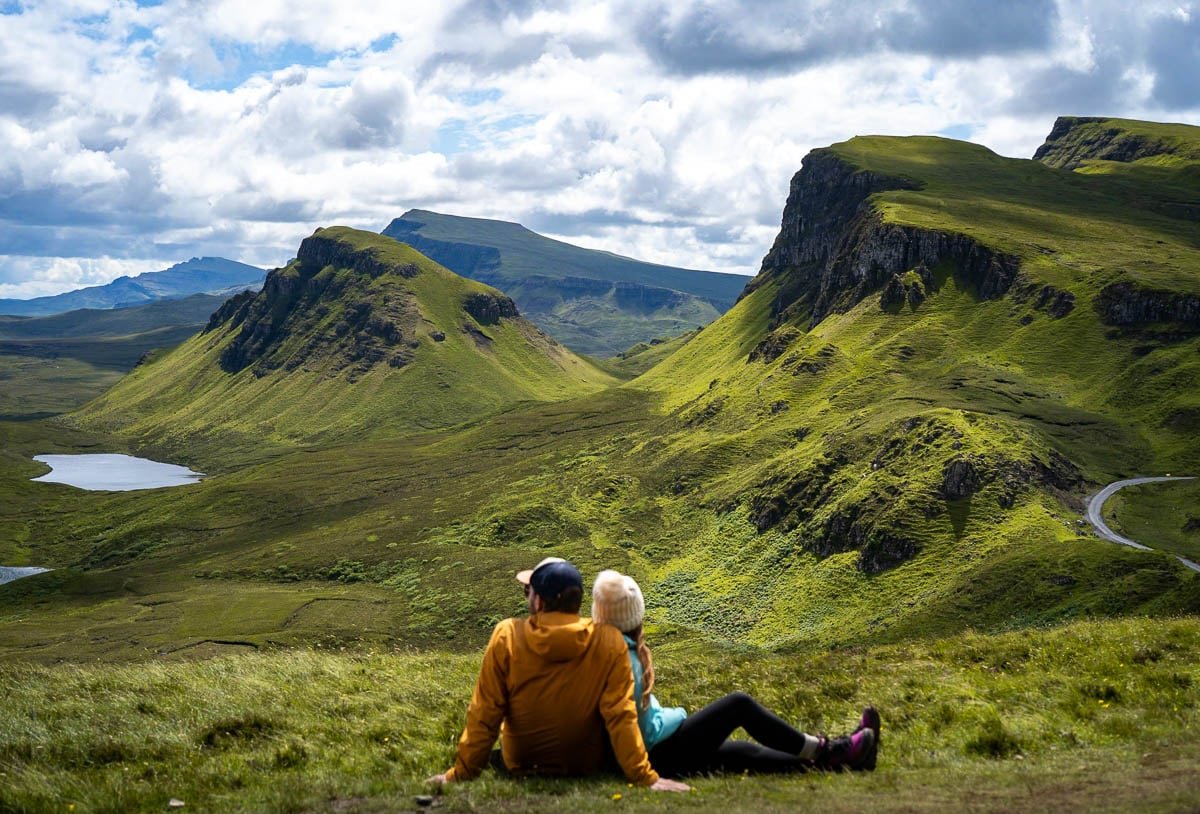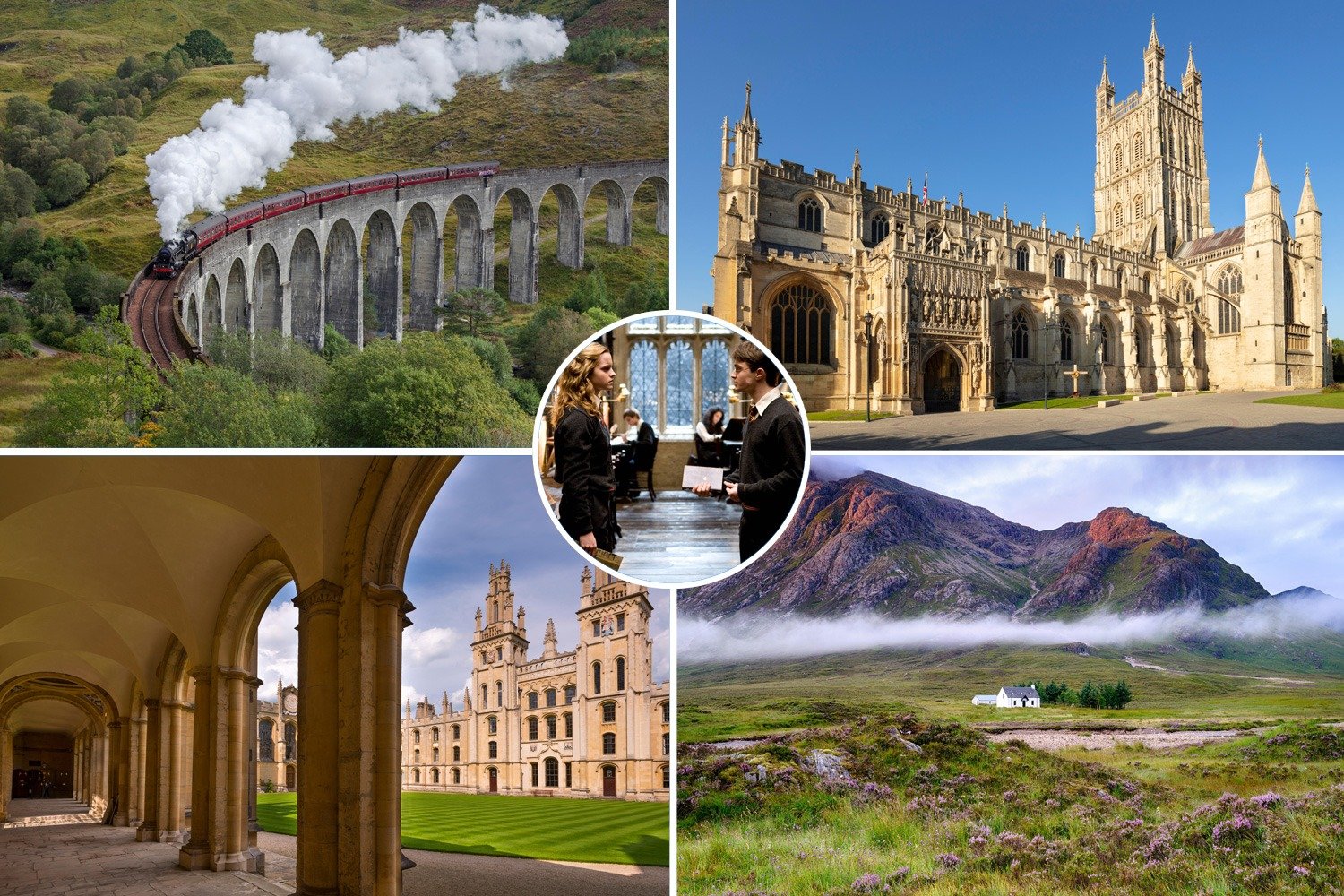Your cart is empty Continue Shopping
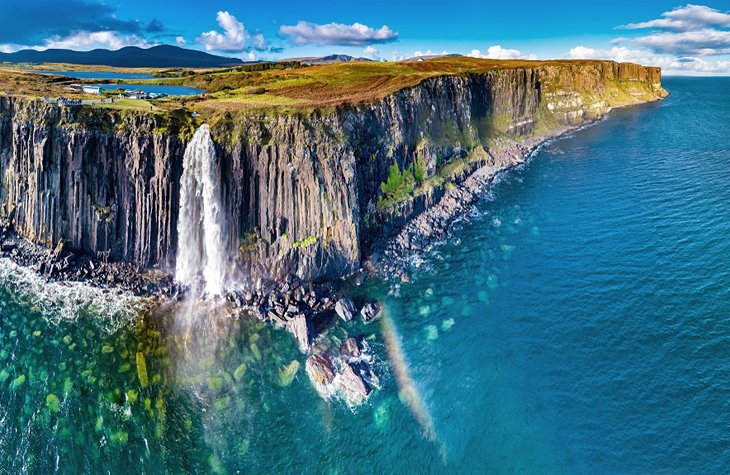
Top 15 Unforgettable Things to Do on the Isle of Skye
The Isle of Skye, a Scotland’s Inner Hebrides gem, is a true land of myth, legend, and breathtaking scenery. Its visually stunning coastlines, majestically beautiful mountain ranges, and enchanting folklore earn it the title of Scotland’s most visited destination. With rock formations that seem to be from other worlds, to ancient castles steeped in history, there is an adventure for every traveler in Skye that look for things to do on the Isle of Skye. Planning your trip can be as iconic as the island itself, but with so many things to see and do, how do you get started?
This guide will lead you through the top 15 things to do on the Isle of Skye, so that you can experience and do the best of this magical island. For individuals who desire to experience these delights but don’t want the hassle of organizing every detail, there are lots of great alternatives for partaking in one of the many excellent available Isle of Skye Tours.
1. Hike to the Old Man of Storr
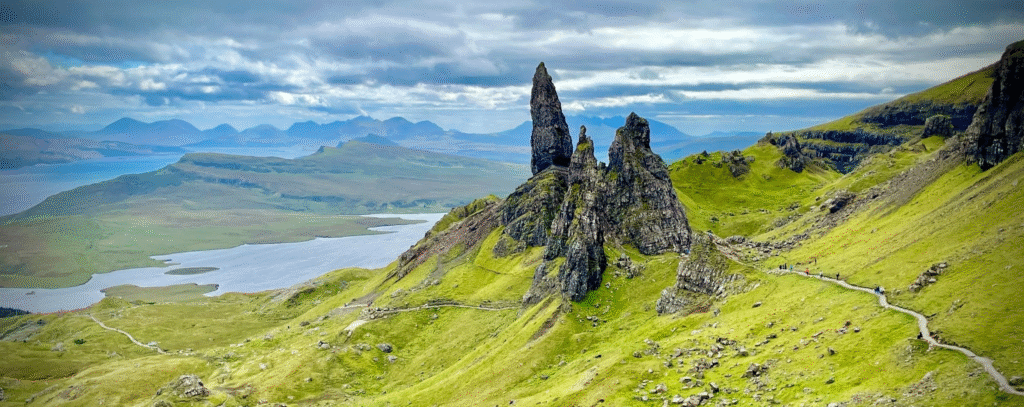
Scanning a broad sweep across the Trotternish Peninsula skyline, the Old Man of Storr is arguably the most photographed and iconic monument on the Isle of Skye. No tour of the island would be complete without a close encounter with this natural phenomenon. After towering as a part of an immense landslip dating back to ancient times, this great rock pinnacle commands such a dramatic and awe-inspiring setting that it has served as the setting for various movies, such as Ridley Scott’s Prometheus.
It is said the Old Man was a giant who lived on the Trotternish Ridge. When he was buried, his thumb—the “Old Man”—remained protruding from the earth and became the spur we know today.
The Hike: What to Look Out For
The walk up to the viewpoint is a must for every able-bodied visitor and the best way to fully appreciate the enormity of the rock formation.
- Location & Parking: The trailhead is within 15 minutes’ drive north of Portree on the A855. There is a large pay-and-display car park at the bottom, but it fills up very quickly, especially in high season. To be sure to have a parking spot, arrive early in the morning (before 9 AM) or late afternoon.
- Distance and Time: The main path to the classical viewpoint and back is approximately 3.8 km (2.4 miles) and typically takes 1.5 to 2 hours, depending on your fitness level and how many photo stops you make.
- Challenging: The walk is moderate. Though the trail is decent condition for most of the way, it’s a continuous and steep climb from the beginning. However, the terrain is a mix of stone steps and gravel path, with a tendency to become muddy and slippery when wet.
- The walk begins with a clear path winding its way up. As you ascend, the view behind you unfolds, offering stunning views over the Raasay Sound and mainland beyond. The final ascent leaves you well down in the heart of the sanctuary, which you loop around with great rock formations. The classic photograph is from a hillock, out over to the Old Man, the jagged pinnacles of “The Needle” and towering cliffs providing a backdrop. For best lighting and least crowds, a sunrise visit is unforgettable.
Tips for things to do on the Isle of Skye:
- Dress with Proper Footwear: Waterproof, sturdy hiking boots with good traction are required. This is not a trainers or shorts walk.
- Dress in Layers: Skye’s weather is famously unpredictable. A sunny walk from the car park can instantly turn to wind, rain, and mist at the top. Bring a waterproof.
- Stay on the Path: For your own safety and to prevent erosion, please remain on the pathed routes. There are unfenced edges and loose ground off the track.
It’s a hike that rewards you tenfold for your effort, leaving you with an unforgettable memory and photographs that will be the envy of everyone back home. It’s perfect when searching top things to do on the Isle of Skye.
2. Explore the Otherworldly Quiraing

If the Old Man of Storr is Skye’s iconic postcard, the Quiraing is its epic fantasy novel. This vast and dramatic landslip on the northernmost part of the Trotternish Peninsula has created a landscape so unique and breathtaking it feels as though you’ve stepped onto the set of a Hollywood blockbuster—which isn’t far from the truth, with the area featuring in films like Stardust and The BFG.
The Quiraing is named after the Old Norse ‘Kví Rand’, or ‘Round Fold’. Within this “fold,” a progression of surreal rock formations, hidden plateaus, and jagged pinnacles await. The most famous of these structures are “The Prison,” a medieval keep seen from a distance, the jagged and intimidating “Needle,” and “The Table,” a hidden, perfectly flat grassland that, according to legend, was used by clans as a hideaway for their cattle from Viking raiders.
The Hike: What to Expect
Walking the Quiraing is part of the quintessential Skye experience, offering a genuine sense of rough adventure in things to do on the Isle of Skye.
- Location & Parking: The place to begin is the pay-and-display car park at the summit of the single-track road between Staffin and Uig villages. Like Storr, this car park is tiny and fills up very quickly. Arriving early, prior to 9 AM or later in the afternoon, is highly recommended in order to secure a parking space.
- Distance and Time: The whole Quiraing circuit is approximately 6.8 km (4.2 miles) and usually takes between 3 and 4 hours to do. But the majority of walkers opt for walking the first half of the route out and back, which offers the best scenery and should take from 1.5 to 2 hours.
- Difficulty: The whole loop is graded as difficult. It is narrow, rough, and follows steep slopes with significant drops in some parts. It requires a good head for heights and steady footing, especially if it has rained because it becomes extremely muddy and slippery. The initial section is much more accessible and suitable for most walkers.
The walk begins on a track that immediately immerses you in the breathtaking scenery. Unlike the Storr hike, you do not need to climb so far to access the stunning views; they are there right from the start. The path twists its way below the cliffs, taking you by The Prison and to The Needle. This part is more than enough “wow” for those not completing the full loop. The whole circuit does involve an open, typically boggy scramble at the other end to get up onto the ridge before descending back down the clifftops.
Top Tips for things to do on the Isle of Skye:
- Cautiously Inspect the Weather: Due to the openness of the path and the steep clifftops, this walk is not recommended in high winds, heavy rain, or thick mist. The weather can become very bad very rapidly.
- Better Shoes Are Not up for Negotiation: Deep-treaded waterproof hiking boots with sturdy ankle support are a must to walk on the muddy, rough, and often slippery terrain.
- Know Your Limits: The landscape during the first 30-45 minutes of the hike is magnificent. There is no shame in enjoying this segment and turning around if you are uncomfortable with the weather or the ruggedness of the entire loop as a whole. Your safety is paramount.
The Quiraing is not a walk, it’s an exploration of a shifting landscape. It’s a place that will leave you feeling small compared to the raw power of nature and provides a strong sense of discovery at every corner.
3. Take a Dip in the Fairy Pools

Located in the spectacular landscape of Glen Brittle, below the imposing Black Cuillin hills, the enchanting Fairy Pools are a secret treasure. This natural wonder is a series of crystal-clear, turquoise pools and cascading waterfalls draining from the River Brittle. It is said that these magical pools are where fairies bathe, and as you look at the pure mountain water tumbling down the rocks into the vividly coloured pools, it’s not difficult to see why this place is so magical.
The magic of the Fairy Pools is twofold: the stunning walk down the glen and, for the brave, the opportunity for one of the most stunning wild swims in the world.
The Walk: What to Expect
The walk to the pools is all part of the experience, with spectacular vistas of the Black Cuillins that encircle them.
- Location & Car Parking: Fairy Pools are located off a single-track road near Glen Brittle. A large, official pay-and-display car park has been built in recent years and is operated by the community trust of the area (OTA) to cater to the popularity of the place. Visit early (before 10 AM) or late in the afternoon to secure a spot since it still gets crowded during holiday seasons. It is paid for on card or an app.
- Distance and Time: Walking between the car park and the main pools and back again is around 2.4 km (1.5 miles). You would give at least 1 to 2 hours for the walk itself, depending on how much time you have to spare for a swim, paddling, or taking photos.
- Difficulty: The hike is generally easy to moderate. The path has been significantly improved but remains rocky and uneven in places. It involves a number of small river crossings over large stepping stones, which in rainy conditions are dangerous when the water is higher.
The path follows the river upstream, each bend opening into a new waterfall or pool more breathtaking than the last. The color contrast between the bright blue-green water and the dark, harsh Cuillins rock is a photographer’s nirvana.
Famous Wild Swim
The best Fairy Pools experience is really getting into the coolingly cold water.
- Be Prepared: The water is fed by mountain streams and is extremely cold, even on the hottest day of summer. A wetsuit is highly recommended if you plan on spending longer than a few minutes in the water.
- The Underwater Arch: Perhaps the most popular feature is a natural underwater arch connecting two pools. It’s a popular place for adventurous swimmers to swim underneath, an iconic photo shoot.
- Safety First: Hypothermia is a real threat. Know your limits, don’t linger in the water too long, and be prepared with a towel and warm dry clothes to change into as soon as you’ve emerged.
Key Tips for things to do on the Isle of Skye:
- Waterproof Shoes are Essential: While you may not plan on swimming, waterproof walking boots are an essential for tramping up the muddy bits and river crossings in comfort.
- Beware of the Midges: Like so many beautiful spots near water in Scotland, the Fairy Pools can be midge heaven on still, wet days from May to September. Come prepared with a good insect repellent.
- Leave No Trace: The pools’ popularity has had an environmental cost. Kindly take all your garbage with you and remain on the trails so that this magical place is conserved for generations to come.
Planning your next trip to Scotland?
Check our our amazing Isle of Skye tours packages.

4. Catch a Sunset at Neist Point Lighthouse
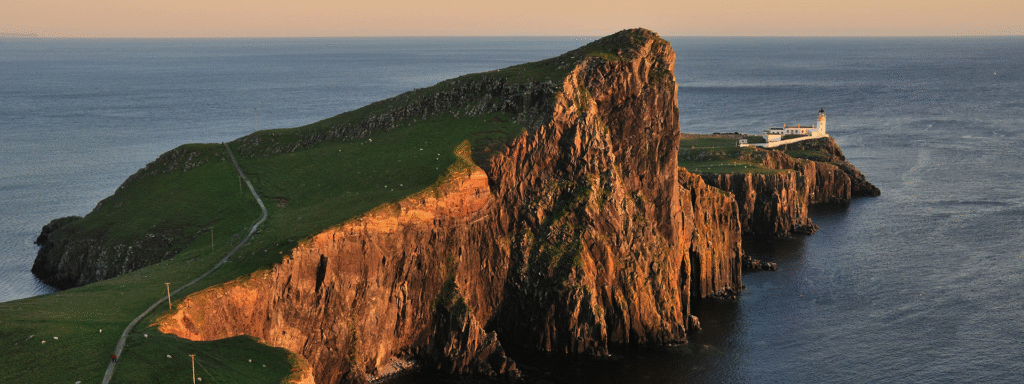
Dramatically perched on the very end of a rugged cliff at the most westerly point of Skye, Neist Point Lighthouse is the island’s finest setting for watching a sunset. The highly photographed lighthouse, created by David Alan Stevenson and initially lit in 1909, is a lone watchman over the infinite expanse of the Atlantic Ocean. A journey here is a journey for photography buffs and nature lovers alike, offering one of the most breathtaking shoreline views to be found anywhere in Scotland.
It’s not only about the lighthouse itself; it’s the dramatic approach, the enormity of the cliffs, and the enchanting glow as the sun lowers in the horizon, typically backlighting the distant Outer Hebrides.
The Walk & The Viewpoint: What to Expect
Walking up to the lighthouse and finding the famous viewpoint involves a memorable cliffside walk.
- Location & Parking: Neist Point is at the end of a long, single-carriageway road (the B884) at the tip of the Duirinish peninsula. The journey itself is scenic, but requires careful driving. There is a small, free car park at the road terminus, but it fills amazingly fast, especially on good nights. Plan to park sensibly on the verge and walk that little bit further.
- Distance and Time: The round hike from the path to the lighthouse and back is approximately 2.2 km (1.4 miles). The walk will only take around 45 minutes to an hour, but you must take much longer time to enjoy the sights, awe, and wait for sunset.
- Difficulty: The trail is moderate. A concrete sidewalk with railing and steps drops steeply all the way to the lighthouse. The sidewalk itself is easy to walk on, but the descent is tough on the knees, and the ascent back is a grueling climb that will leave you huffing.
Finding the Famous “Postcard” View
While the walk down to the lighthouse is worth it, the most photographed scenery of Neist Point is not along the path. To get this classic view, do not start going down the concrete path immediately. From the car park, walk towards the cliff edge and go down the grassy path which bends to the right. This route follows the rim of the cliffs, and there is a good view from the top over to the lighthouse on its rocky promontory.
Sunset and Wildlife Spotting
This is where Neist Point comes into its own. As the sun sets, sea and sky turn a stunning array of orange, pink, and purple hues. It’s a great spot for spotting marine life. Keep binoculars close at hand below on the water and scan out for minke whales, dolphins, porpoises, and even basking sharks during summer. The cliffs also attract a whole variety of seabirds like gannets, guillemots, and razorbills. It’s a top on the list of things to do on the Isle of Skye.
Key Tips on things to do on the Isle of Skye:
- Mind the Cliffs: This should go without saying. The cliffs are unfenced and highly dangerous with sheer drops. Keep well back from the edge at all times, particularly on windy days or when trying to take a photo.
- Bring a Torch/Headlamp: You will be climbing back up the steep path in the dark if you are coming back at sunset. A light source is absolutely essential for a safe return.
- Check the Weather: The top is highly exposed. Strong winds can make it unsafe to walk, and mist can obscure the view. Make sure to check the weather forecast before you set out.
- Arrive Early: For an evening visit, try to arrive at least 1-2 hours early to get parked and in a good vantage point to watch the show.
- Wear Strong Shoes: Even with the concrete path, steepness means that strong shoes with a solid grip are an extremely sensible option.
5. Step Back in Time at Dunvegan Castle & Gardens
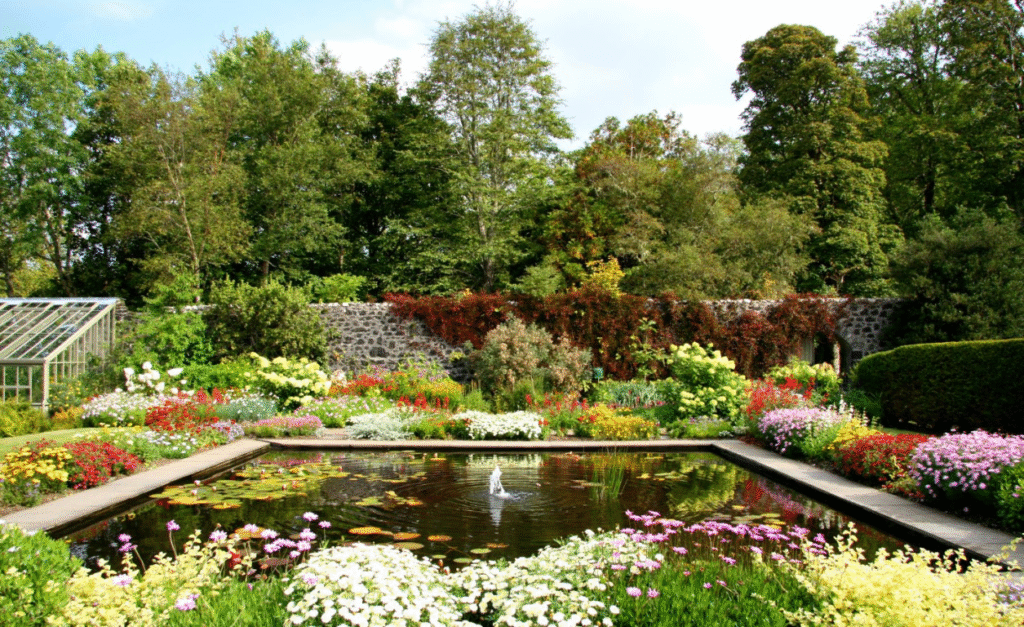
Looking out over Loch Dunvegan, Dunvegan Castle stands tall as the holder of Scotland’s oldest continuously occupied castle record. It has been home to the Chiefs of Clan MacLeod for over 800 years, so a visit to the castle is not only an exploration of historical grounds, but a step into a living heritage. In contrast to the many ruined castles that dot the Scottish landscape, Dunvegan is a vibrant estate, filled with irreplaceable heirlooms and centuries of clan heritage.
A visit to the castle is an exciting journey through the centuries, with each room telling another chapter in the MacLeod story, and a must on your list of things to do on the Isle of Skye.
Inside the Castle: Heirlooms and Legends
The castle’s interior is a museum of art and artifacts. Among the grand drawing room, grimy dungeon, and state bedrooms, two things especially capture every visitor’s imagination:
- The Fairy Flag: The most famous of all the MacLeod possessions, the legendary Fairy Flag is a fragile, silk banner dating as far back as the 4th century. Surrounded in myth, the flag allegedly was presented to the clan by the fairies. It is said to have mystical powers and, when unfurled in combat, has saved the clan from defeat on numerous occasions. Having laid eyes upon this mysterious and revered artifact is an experience never to be forgotten.
- Rory Mor’s Horn: This glorious drinking horn is among the most sacred of the clan treasures. Clan tradition demands that every new chief prove his manhood by draining the horn, brimming with claret, at a single gulp without setting it down. It’s a symbol of the strength and endurance required of a MacLeod chief.
The Magnificent Gardens
In sweet and beautiful contrast to the wild, dramatic landscape of Skye, the five acres of formal garden at the castle are a verdant and vibrant oasis. Tenderly restored throughout the years, they are a tribute to horticultural expertise in challenging circumstances. You can walk through several different sections:
- The Walled Garden: A former vegetable garden, this is now a breathtaking and diverse mix of flowers and ornamental plants, a riot of colour in the summer months.
- The Water Garden: With bridges, ponds, and a charming aquarium-style waterfall, this section gives a calm and idyllic stroll.
- The Woodland Walk: Twisting paths between mature trees give a tranquil haven and lovely views back towards the loch.
The Unmissable Seal Boat Trip
One of the most favorite things to do at Dunvegan is the 25-minute boat ride on Loch Dunvegan. Setting off from the castle’s own jetty, the boats take you out to observe both common and grey seals lazing on the rocks of the small islands (or skerries). Observing these fun-loving and inquisitive creatures in their natural habitat against the backdrop of the castle is a treat for visitors of all ages and a top list of things to do on the Isle of Skye.
Tips and Essentials for things to do on the Isle of Skye:
- Half a Day’s Plans: In order to enjoy the castle, the gardens, and the seal boat trip in the correct manner without any haste, spend a minimum of 3-4 hours on your tour.
- Check Opening Times: The gardens and castle typically open in April and close in October. Be sure to check their website for up-to-date opening times and ticket prices before you travel.
- Combined Tickets: Tickets for the castle and gardens separately, or a combined ticket covering the seal boat trip, which typically offers the best value.
6. Wander Through the Fairy Glen

While Skye is renowned for its huge, epic landscapes like the Cuillins and the Quiraing, the Fairy Glen (or a’ Ghleann Sìth) offers another kind of magic—one of small, whimsical enchantment. Located near the village of Uig on the Trotternish peninsula, this eerie and unusual landscape isn’t a site of specific folklore, but was so-named because of its otherworldly quality that appears tailor-made for mythical residents.
It’s a bizarre and lovely landslip that’s created a storybook scenery of tiny, perfectly cone-shaped grassy hills, gnarled and twisted trees, and tiny lochans (ponds). It’s a place that invites you not to walk, but to search, seek, and let your imagination go completely wild.
Finding the Miniature World
The charm of the Fairy Glen is that it doesn’t have one central focal point. The joy is in the discovery.
- The Landscape: You may twist and turn amongst the low, conical hills, a giant in a miniature world. The landscape changes constantly, with hidden hollows and strange forms around each corner.
- Castle Ewen: The most prominent feature is a natural rock formation that stands tall on one of the hills, resembling a ruined medieval tower. This is known as “Castle Ewen.” It’s possible to scramble to the top for a fantastic panoramic view over the entire glen. The small cave in its base only adds to the mystique.
- The Stone Spirals (A Word about Responsible Tourism): Visitors over the years have been creating spirals on the ground from loose stones. While photogenic, this is now positively discouraged. It interferes with the fragile ecosystem and detracts from the glen’s natural beauty. The local community goes to great trouble to remove them. The best is to leave the glen exactly as you found it for others to enjoy.
The Visit: What to Expect
Unlike other Skye attractions, the Fairy Glen is less a walk than a leisurely amble. It’s a top attraction on things to do on the Isle of Skye.
- Location & Parking: This is absolutely vital. Due to popularity, the single-track road that leads into the glen is generally closed to visitor traffic. A new pay-and-display car park has been built a short distance off (approximately 1 km / 0.6 miles) before the glen itself. You must park here and then walk the remaining distance. Please don’t attempt to drive into the glen or park on the verges, as this causes serious issues for both residents and emergency vehicles.
- Distance and Time: There is no set route. You can spend as little as 30 minutes or as much as a few hours looking around. A typical visit, allowing for the walk from the car park, would last around 1.5 to 2 hours.
- Difficulty: The walking is easy. The terrain is grassy and can be rough and boggy in places after rain, but there are no steep, long climbs unless you choose to scramble to the summit of Castle Ewen. It’s an excellent choice for families with children.
Essential Tips for things to do on the Isle of Skye:
- Observe the “Leave No Trace” Policy: This is the most important rule for the Fairy Glen. Leave nothing behind but bubbles, take nothing but memories. Don’t move stones, build spirals, or leave any item behind.
- Decent Footwear is Still Recommended: Although it’s a simple walk, the ground can be very muddy and slippery. Waterproof shoes will make your experience much more enjoyable.
- Get Enchanted: The Fairy Glen is a place of serene contemplation and fantasy. Throw away the map, wander at random, and create your own fairy tale in this uniquely enchanting part of Skye.
7. Admire Kilt Rock and Mealt Falls
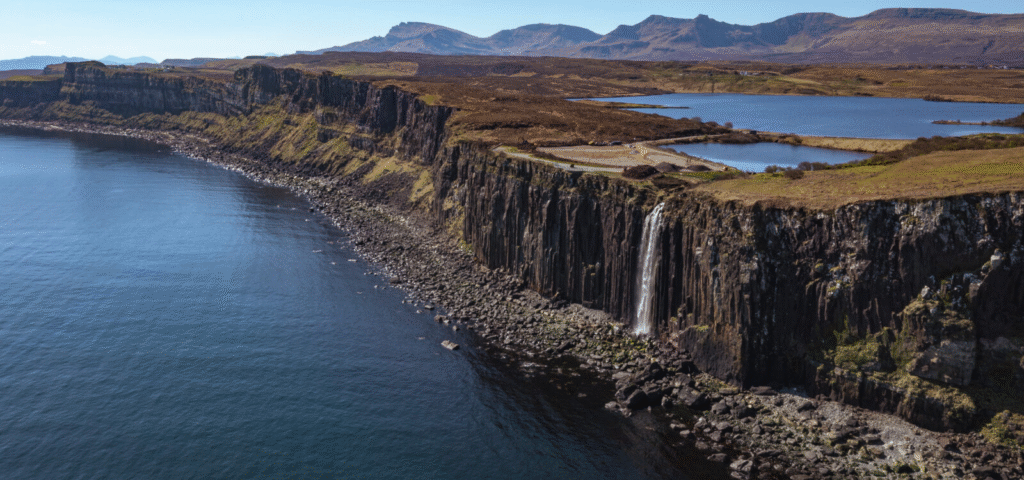
Offering one of the most spectacular “two-for-one” experiences of the natural world, Kilt Rock’s lookout offers you two of Skye’s most breathtaking geological wonders from one readily accessible spot. On the east coast of the Trotternish Peninsula, it is an unmissable roadside spot on any island tour, presenting a dramatic demonstration of sea power and loveliness.
Kilt Rock: A Geological Masterpiece
The show-stopper is the towering sea cliff known as Kilt Rock. Imagine a cliff face so beautifully shaped that it resembles the neat, vertical creases of an old-fashioned Scottish kilt—precisely what you will see. The “pleats” are actually huge columns of dolerite, a volcanic rock, that were created during the Jurassic period. These dramatic vertical striations, along with the differently coloured rock strata, bear a disconcerting resemblance to the celebrated tartan jacket. It’s an imposing and visually stunning example of the unique geology that defines the Isle of Skye, and a top on the list of things to do on the Isle of Skye.
Mealt Falls: A Dramatic Plunge
But the visual feast doesn’t end there. Off on the left of the head cliff face, you’ll see and hear the breathtaking Mealt Falls. Free-falling cascade, this one is fed by the adjacent Loch Mealt, which is tucked out of sight behind the viewing point. The falls thunder over the cliff edge, plummeting about 60 meters (180 feet) in a single unbroken curve into the foamy waters of the Sound of Raasay below.
The experience is a feast for the senses: the sight of the water seeming to vanish into the sea, the thunderous crash as it bursts forth, and the salty spray on your cheeks. On very windy days, the display is even more breathtaking, for the fierce blasts of wind can toss the water from the falls back up the side of the cliff, creating the illusion that the waterfall is going into reverse.
The Viewpoint Experience
One of the best aspects of Kilt Rock and Mealt Falls is how readily accessible it is, and it is a perfect destination for all ages and mobility groups to pull over.
- Location & Parking: The site is located off the main A855 road running between Staffin and Portree. There is a free dedicated car park mere feet from the viewpoint.
- The Viewing Platform: There is also a fenced-off viewing platform safely built at the cliff edge itself, offering a safe but breathtaking panorama. You don’t have to hike or walk very far at all—the view greets you as soon as you step out of your car.
- Time Needed: This is a relatively quick stop. You can soak in the breathtaking views and snap plenty of photos in 15-20 minutes, so it shouldn’t be difficult to fit it into a busy day of sightseeing.
Top Tips for things to do on the Isle of Skye:
- Pray for Rain (and Wind!): While sunshine is nice, the falls are most spectacular and in all their glory following a bout of heavy rain. A windy day offers the added bonus of seeing the famous “upside-down” waterfall effect.
- Combine with Other Attractions: Kilt Rock is perfectly placed on the Trotternish circuit, so it is an excellent spot to combine a visit with going up to the Old Man of Storr and the Quiraing.
- Photography: To photograph Kilt Rock and Mealt Falls in a single shot, you’ll appreciate the use of a wide-angle lens.
- Dinosaur Museum: Conveniently also situated right next to the car park is the Staffin Dinosaur Museum, a diminutive but engaging museum that is well worth a brief drop-by if your interest lies in the area’s diverse fossil history.
8. Discover Portree’s Colourful Harbour

The vibrant capital and largest town on the Isle of Skye, Portree is the island’s bustling heart. Its Gaelic title, Port Rìgh, or “King’s Port,” is believed to commemorate a visit by King James V in 1540. Today, it is the island’s undisputed hub of culture, commerce, and tourism, but its most unbeatable attraction is its picture-postcard harbour. It’s perfect for things to do on the Isle of Skye.
Fringed with a neat row of brightly painted houses in pink, yellow, blue, and green, the harbour is one of the most photographed vistas in Scotland. The time-honoured scene, enclosed by the wood-covered hills and the sheltered waters of the bay, offers a sharp contrast to the wild, windswept landscapes that define so much of the rest of Skye.
The Harbour and Beyond
Although the vibrant quay is the main attraction, the town itself is a pleasant spot to spend a few hours or to utilize as a base for your island adventures.
- The Harbour View: To get the most from the harbour, there are two things to do. First, walk along the quay itself, where you can watch fishing boats coming and going and read the menus of the excellent seafood restaurants. Second, for the traditional photograph, take the brief hill walk on the north side of the bay (in the Scorrybreac walk direction) to get a fine elevated view looking down over the harbour’s brightly coloured buildings.
- A Foodie Paradise: Portree boasts the island’s best and most varied selection of restaurants. From award-winning restaurants serving up locally sourced scallops and venison, to cozy pubs serving up comforting food and, of course, classic fish and chips to be enjoyed by the harbor, there’s something to suit every taste and budget.
- Shopping and Amenities: The town centre, clustered around Somerled Square, contains a variety of independent shops, art galleries, outdoor gear suppliers, and souvenir shops. It’s great for picking up a locally made gift, a woolly jumper, or simply stocking up at the supermarket.
Your Base for Exploration
Portree’s central location makes it an ideal strategic base for exploring the rest of the Isle of Skye. The Trotternish Peninsula, the Old Man of Storr, and the Quiraing are all a short drive to the north, and Dunvegan Castle is an easy drive to the west. Its concentration of accommodation, from hotels and B&Bs to hostels, also makes it a convenient and convivial place to base yourself.
Practical Visitor Tips on things to do on the Isle of Skye:
- Parking Can Be Difficult: Portree gets very crowded, especially in peak season. There are two main pay-and-display car parks: one at Somerled Square (town centre) and a larger one at the Bayfield location near the co-op. Arrive early or be prepared to wait.
- Book Accommodation and Dining in Advance: If you plan to eat at one of the more popular restaurants or stay overnight during the summer months, booking in advance is essential to avoid disappointment.
- Take Time to Ramble: Although you can see the harbour in 15 minutes, Portree rewards those who linger. Allow at least a couple of hours to explore the back streets, window shop, and soak up the lively atmosphere that makes it the true capital of Skye.
9. Sample a Dram at Talisker Distillery

No visit to the Isle of Skye would ever be truly complete without a taste of the strong spirit it produces. Standing on the windy shores of Loch Harport in the village of Carbost, Talisker Distillery is the island’s oldest working distillery. For nearly 200 years, it has been producing a single malt whisky as dramatic and wild as the landscape that encircles it, and a trip here is a must pilgrimage for whisky aficionados and curious travellers alike. Make sure to check it on your list of things to do on the Isle of Skye.
The distillery’s famous slogan, “Made by the Sea,” is no marketing gimmick; it’s a statement of identity. The salt, sea air’s nautical flavor is infused into every process of the whisky-making process, making Talisker what it is so distinctively. The result is a rich, multifaceted “liquid gold” that captures the essence of Skye: rugged, smoky, peppery, and possessing a long, warm finish that defies island conditions.
The Distillery Tour & Tasting Experience
The tour of Talisker takes you behind the scenes of this top-shelf facility. As a recent complete overhaul, the experience of the visitor is more immersive than ever before.
- The Tour: You get to go on a tour of the production process, right from mashing malted barley to fermentation in wood washbacks. The tour highlight for most is seeing the five gleaming copper pot stills, not to mention the quirky swan-necked lye pipes which add to Talisker’s unique character. You will learn about the “angel’s share” and the role of the oak casks in maturing the spirit.
- The Tasting: The pinnacle of any visit is, of course, the tasting. Depending on which tour you’ve arranged, you’ll be taken through a tasting of several different expressions of Talisker. This is your chance to fully appreciate its iconic flavour profile: a crashing wave of smoky peat, a characteristic “Talisker pepper” spice that strikes the palate, with dried fruit and a long, comforting finish. It’s a powerful symphony of flavor that is both challenging and incredibly rewarding.
- The Visitor Centre: The modern, sleek visitor centre has a shop that’s properly stocked with the full range of Talisker, including distillery-only releases you can’t get anywhere else. And there’s also a high-quality super bar with stunning views over Loch Harport, where you can have a dram or whisky cocktail.
Tips and Tricks for things to do on the Isle of Skye
- Book Early in Advance: Talisker is highly popular, and tours tend to sell out weeks, if not months, ahead of time, especially in high season. Online booking on their website is absolutely required in an effort to secure your spot.
- Arrange a Designated Driver: Scotland also has very strict drink-driving laws. If you drive, you cannot drink. Arrange beforehand and the designated driver, or utilize the tasting packs that allow drivers to take samples home with them.
- Location and Time: It is based in the village of Carbost off the A863. Allow at least 1.5 to 2 hours for an entire tour and tasting experience.
Check Tour Options: Talisker offers a range of different tour and tasting experiences, from basic tour to more in-depth masterclasses. Check their site to see which one suits your interest and budget.
10. Conquer the Cuillin Mountains

Rising in sweeping sweeps like serrated teeth from the very center of the island, the Cuillin Ridge is Skye’s unqualified alpine spirit. Not a series of resplendent hills; this is the most challenging and hardest mountain country anywhere within the United Kingdom. Their towering, sombre ridges dominate the skyline from almost every point on the island, defying the adventurous and commanding respect from all who lay eyes upon them. For experienced hillwalkers and experienced mountaineers, the Cuillins are the ultimate test. It’s top for things to do on the Isle of Skye.
The range is famously split into two very different halves:
The Black Cuillins: A Mountaineer’s Paradise
When other people mention the Cuillins, they are referring to the Black Cuillins. They are the middle, principal peaks, a 12km horseshoe of gabbro rock that is devilishly sharp and famously grippy when dry but hazardous when wet. This is serious mountaineering terrain, not hillwalking.
- The Ground: The Black Cuillins contain steep exposed scrambles, knife-edge ridges, and technical climbing. The range possesses 11 Munros (Scottish mountains over 3,000 feet), of which the infamous Inaccessible Pinnacle—a rock fin on Sgùrr Dearg that must be accessed by a rock climb—is the only Munro which can’t be climbed using scrambling or walking alone.
- The Challenge: The ultimate challenge of UK mountaineering is the full Cuillin Ridge Traverse, a marathon adventure linking all the major summits in one continuous journey. It requires high-class fitness, expert-level navigation, ropework skill, and healthy head for heights.
Red Cuillins: A Hiker’s Challenge
East of the Black Cuillins lie the Red Cuillins. Made up of granite, their slopes are less rough, more rounded, and covered with scree, which imparts a reddish hue to them. Whilst still a significant challenge that should not be trivialized, they are far more accessible to competent hillwalkers who are not technical climbers. Such tops as Glamaig and Marsco offer arduous but non-technical climbs with panoramic views of their darker, more craggy neighbours.
Viewing the Cuillins Without the Climb
There is no need to be a climber to behold the stunning grandeur of the Cuillins.
- Sligachan Bridge: One of Scotland’s most iconic scenes lies at the historic Sligachan bridge, offering an idyllic and easily accessible view into the heart of the range where Black and Red Cuillins meet.
- Loch Coruisk: A boat trip from Elgol into this fresh-water loch places you in the heart of the mountain amphitheatre, surrounded by stupendous peaks—a profoundly humbling experience.
- Glen Brittle: A stroll along the tracks at the foot of the mountains, including that leading to the Fairy Pools, is a means of appreciation of their gigantic proportions from the bottom up.
A Important Comment on Safety
The Cuillins are a serious and hazardous terrain.
- Weather: Weather can change overnight and mist can thicken undetected, making it impossible to traverse.
- Navigation: The Black Cuillins’ gabbro rock is magnetically so strong that compass reading could be ruled out. Good map-reading skills and a GPS are required.
- Engage a Guide: If any attempt is being made seriously on the Black Cuillins, employing a trained local mountain guide is not only advisable; it’s compulsory for most travelers. They bring the safety gear, route familiarity, and expertise required to get through these mountains in safety.
Need a Scotland transfer service?
We have a lot of options for you

11. Find Dinosaur Footprints at Staffin Beach
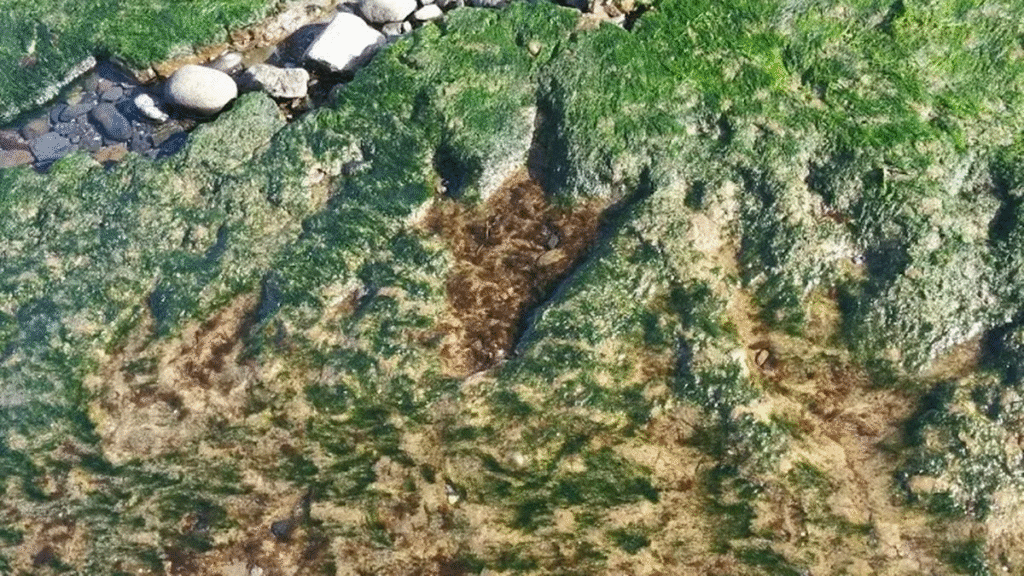
While the Isle of Skye abounds with human history, legend, and myth, it possesses a much deeper, much older narrative—a prehistoric one. You can walk in the giant’s footprints at An Corran beach along the coast, close to the village of Staffin. This is not hyperbole; you can find genuine, fossilized dinosaur footprints in the rock here, dating back an astonishing 165 million years to the Middle Jurassic era.
Discovered in 2002, these remains have turned this serene part of the Trotternish Peninsula into a site of global paleontological interest. Discovery is less like visiting a museum than it is a treasure hunt which instantly connects you to the times when such monumental beasts roamed this very ground. You can’t miss them on your things to do on the Isle of Skye.
The Hunt: What to Find and Where
Finding the prints is an adventure in itself. They’re not marked, but that adds to the sense of discovery.
- The Footprints: The most famous group of prints is that of an ornithopod, which was a family of large, two-legged plant-eaters. Look for groups of three-toed tracks about 50cm long. They can be hard to spot as they tend to be sand-filled, water-filled, or covered with a layer of seaweed. They look enormous, strange bird footprints in the flat bedrock.
- The Location: Go to An Corran beach at Staffin. Slide down the concrete slipway onto the beach. The most significant location of bedrock is to the right of this slipway with the sea in front. The prints are on the horizontal, grey-appearing rock shelf that is exposed at low tide.
The Key Rule: Timing is Everything
This is the single important tip for your trip: The dinosaur footprints are only visible at low tide.
The platform on which the prints are standing is completely surrounded by sea for most of the day. It is not worth attempting at high tide. Before you plan your trip, you must check the local tide times on the internet at Staffin or An Corran. Plan your trip when it is about an hour or so before low tide so that you have the best possible time to search.
Staffin’s Jurassic Coast
An Corran’s tracks are just one part of the site’s marvelous fossil record. Just down the road on the beach from An Corran is the Staffin Dinosaur Museum. The little but fascinating museum was initiated by resident man Dugald Ross, who has discovered most of the area’s most significant fossils. It holds an amazing collection of bones, teeth, and other fossilized material that provides context and fleshing out the bones of Skye’s dinosaurs.
Key Tips for things to do on the Isle of Skye:
- Visit the Tide Times: We cannot stress this enough. This is the difference between a successful hunt and seeing nothing but sea.
- Wear Grippy Shoes: Seaweed-covered rocks are extremely slippery on the beach. Wear waterproof, sturdy shoes with good grip to be safe.
Be Patient and Observant: Do not hurry. Get a close look at the rock surfaces. The adventure is in the hunt! - Respect the Site: These tracks are a one-time-only part of our world’s history. Please look with your eyes, not your hands. Do not try to destroy, alter, or remove anything from the site.
12. Take a Boat Trip to Loch Coruisk

For those who want to experience the untamed, unspoiled essence of the Isle of Skye, there is no more significant trip than the one to Loch Coruisk. Situated in the jagged, granite clutches of the Black Cuillins, this freshwater loch is among the most remote and spectacularly positioned bodies of water in Britain. It’s a prehistoric landscape, an amphitheater of black, serrated peaks that dip to the water’s edge, a sight of breathtaking and humbling beauty.
Reaching this isolated wonder is an experience in itself, as it is not accessible by road. The classic and most thrilling way of visiting is by boat from the small, picturesque fishing village of Elgol. Make sure to add it on your list of things to do on the Isle of Skye.
The Journey from Elgol: A Marine Safari
The journey by boat across Loch Scavaig is more than just a ride; it’s a vital part of the Loch Coruisk experience and generally one of the highlights of any Skye visit.
- The Scenery: As you leave Elgol, you are treated to stunning coastal scenery. The boat threads its way through characteristic rock formations and sea caves, with the dramatic outline of the Cuillin ridge becoming more and more spectacular as you approach.
- Wildlife Watching: The seas here are alive with marine life. The tour offers an excellent chance to see a variety of seabirds, and it’s a unusual trip that doesn’t encounter the local colony of common seals. You’ll catch them basking idly on the rocks or poking their curious heads above the water to watch you pass by. If you’re lucky, you might even glimpse dolphins, porpoises, or the occasional minke whale.
Stepping into Another World
Disorienting as it is, going ashore at the landing pier for Loch Coruisk is entry into a lost world. Silence closes over you immediately, broken only by the cry of birds and the far-off rumble of waterfalls cascading down the sides of the mountains.
- The Walk: A short, boulder-covered walk from the landing site, over the turbulent River Scavaig via a simple bridge, brings you to the loch’s shoreline. Underfoot is generally straightforward, allowing you to become absorbed in the landscape almost immediately.
- The Experience: Most boat tours spend around 90 minutes ashore, time to walk the shores of the loch, sit on a boulder, and simply drink in the immensity and profound stillness of the place. It’s a perfect spot for a picnic, for photography, or for quiet contemplation. The sheer untouched verticality of the mountains that surround you is something that has to be seen to be believed.
Key Tips for things to do on the Isle of Skye:
- Book Your Boat Tour: There are a number of reputable operators based at Elgol. It is absolutely vital to book your tour in advance, particularly in the high summer season, since there are limited places and they fill up very fast.
- Highly Weather Dependent: All boat tours are weather dependent and may be cancelled at short notice in unfavorable weather. Always check with the operator on the morning of your tour.
- Be Prepared for All Weathers: Cuillin weather is notoriously unpredictable. Even when the sun is shining in Elgol, the loch can be wet, cold, and windy. Full waterproofs (jacket and trouser) and robust, waterproof footwear are essential. It’s always colder on the water.
- No Facilities: Loch Coruisk is in the wilderness. There are no shops, toilets, or shelters. You must be entirely self-sufficient. Bring any food, water, and spare layers that you might need.
- Leave No Trace: This is an unspoiled environment and must be protected. Take all of your litter away and stick to the paths to minimize your impact.
13. Explore the Sleat Peninsula
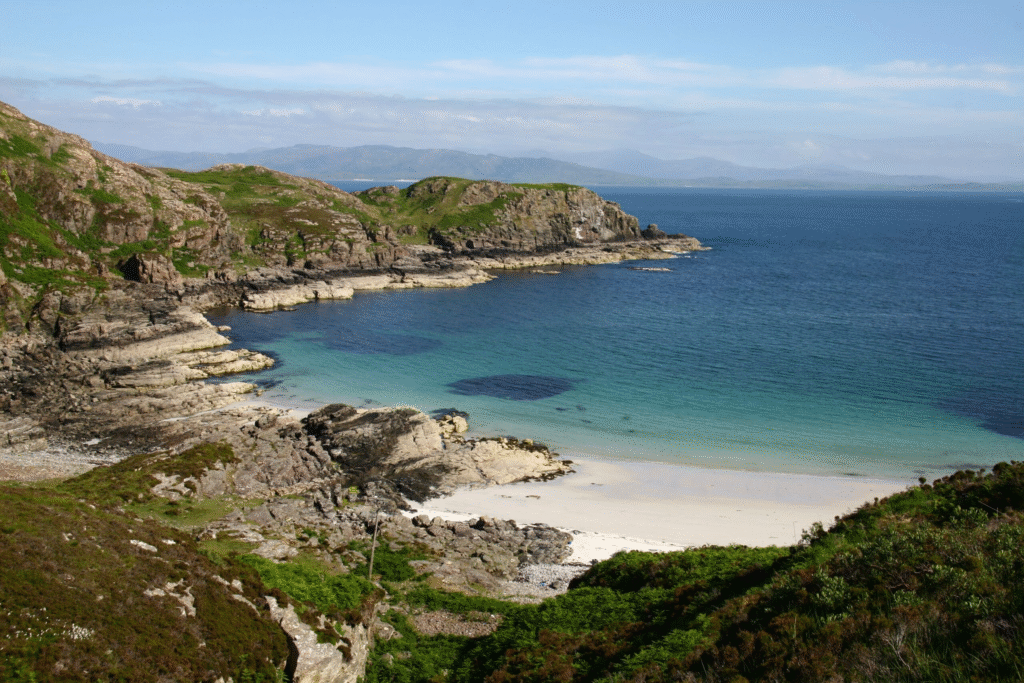
Whereas north Skye’s dramatic, mountainous scenery is apt to be the focus of attention, Sleat (“Slate”) Peninsula in the south displays an intimately contrasting and no less enthralling spectacle. Locally referred to as “The Garden of Skye,” the area offers the island’s calmer aspect. Here, the naked, treeless moors give way to fertile, rolling hills, sheltered bays, and green woods, conjuring an Arcadian and peaceful mood that appears a world away from the brutal theatre of the Trotternish Ridge.
Sleat is greater than a scenic detour; it is a destination unto itself, rich in clan heritage, living Gaelic culture, and hidden treasures to discover. For many, it is the charming and serene entry to the island for those who take the ferry from Mallaig, a top of things to do on the Isle of Skye.
Highlights of the “Garden of Skye”
Armadale Castle, Gardens & Museum of the Isles: The peninsula’s pièce de résistance and spiritual home of the mighty Clan Donald, ancient foes of the MacLeods of Dunvegan. While the principal castle is an angelic, romantic ruin, you can stroll through the lovely 40 acres of historic garden and woodland landscape. The estate also boasts the first-rate Museum of the Isles, a top award-winning attraction that delves into the 1,500-year history of the Highlands and Islands in the guise of Clan Donald, one of Scotland’s most powerful clans.
- Scenic Drives and Hidden Coves: The route through Sleat is a journey in itself. Single-track roads twist through ancient woods and open out onto rugged coast views along the Sound of Sleat to the mainland hills of Knoydart. It’s somewhere best explored slowly.
- Lovely Beaches: Sleat boasts some of Skye’s most lovely and secluded beaches. Look for the stunning sandy beach at Ord, with its mind-blowing, unlooked-for perspective back towards the Black Cuillins. For the more intrepid, there is a walk to the white sands of Camas Daraich, a sweet and remote spot that seems like a hidden gem.
- A Gaelic Culture Centre: The peninsula is an active culture centre for Gaelic arts and culture. It houses Sabhal Mòr Ostaig, the National Centre for Gaelic Language and Culture. There are various art galleries, craft workshops, and pottery shops around the area where you will be able to observe the work of talented local artists motivated by their beautiful landscapes.
Tips to Remember on things to do on the Isle of Skye:
- Gateway to Skye: The Mallaig to Armadale car ferry is a stunningly scenic way to come in or out of Skye. If you go via this route, Sleat will be your first or last impression of the island—so do try to take the time to see it.
- Slow Down and Enjoy: This is not somewhere to hurry through. Stop at viewpoints, take your time, stroll along the beaches, and drop into the tiny galleries. It’s the ideal antidote to the busier “honeypot” attractions in the north.
- Watch out for the Craft Trail: Keep an eye out for boards advertising local craftspeople and artists. A trip to these small workshops offers a wonderful way to buy a personal memento and hear from its maker.
- Fine Food and Drink: Sleat is home to some of Skye’s finest foodie experiences, from luxury hotels down to small pubs, and quite often a menu based on locally caught or foraged ingredients.
14. Visit the Ruined Duntulm Castle
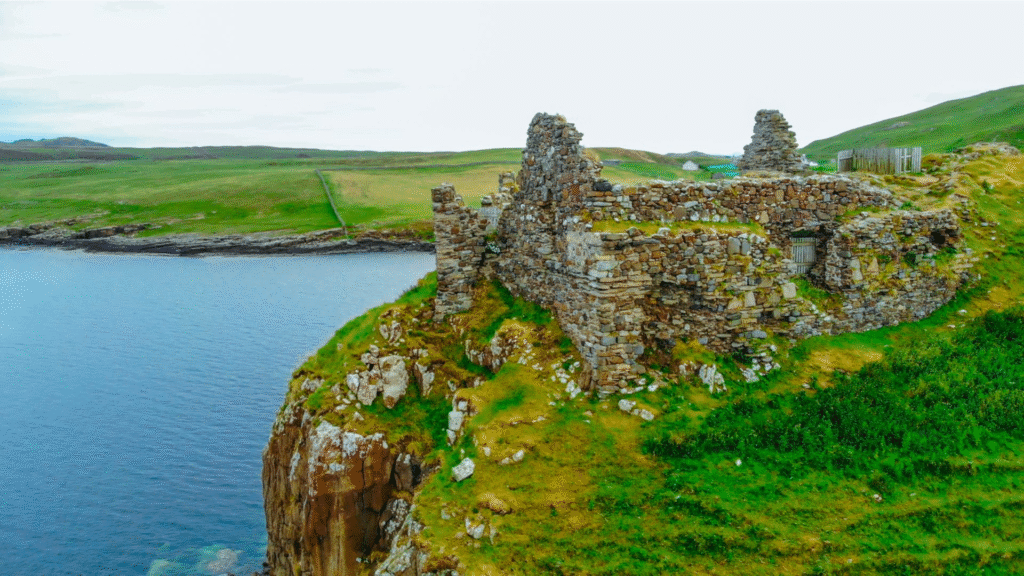
Perched on top of a great, basalt headland at the north end of the Trotternish Peninsula, Duntulm Castle’s remains stand as a wind-swept and ghostly sentinel over remorseless sea. Far from being a great, unbroken fortress, it is a crumbling remnant whose strength now is in its breathtaking location and its tempestuous past soaked in its very stones. For one with a love of atmosphere, raw history, and dramatic coastal views, a trip to Duntulm is a powerful and evocative experience in your things to do on the Isle of Skye.
A History of Rivalry, Betrayal, and Ghosts
Its strategic importance meant that the headland had been occupied from the Iron Age onwards. The castle we are looking at today was once a formidable fortress, fiercely contested by Skye’s two great clans: the MacLeods and their bitter enemies, the MacDonalds of Sleat, who eventually managed to gain control in the 17th century.
The castle’s history is one of dubious tales. Its most famous ghost story is the nursemaid caring for the wee boy of the clan chief. She accidentally dropped the child out of a window on to the rocks below. For a horrific punishment, she was sent adrift in a small boat on the rocky seas of The Minch to fate. Her grief-stricken spirit is reputed to wail amidst the ruins.
The castle is haunted by Hugh MacDonald, who was imprisoned and starved to death in the dungeon after a failed attempt to seize the chieftainship. The MacDonalds left Duntulm Castle later in 1732 for a more comfortable residence at Monkstadt. An additional claim is that a curse was laid on the family line if any of the stones of Duntulm were removed to build their new residence.
The Visit Today: What to See
Duntulm is all about connecting with this raw history and the awesome power of the environment.
- Location and Access: The castle is right off the A855 road, running around the Trotternish loop. There’s a small, official roadside car park. It’s a short walk of about 10-15 minutes along a field from there to reach the remains.
- The Walk: The path is unpaved and extremely muddy and uneven, especially if it has been wet. It’s a straightforward and fairly level walk, though, and it takes you directly down to the cliff edges.
- The Ruins and the View: There isn’t anything left of the castle other than ruined parts of the keep and the perimeter walls. You can’t enter what remains since the building is unsafe and fenced off to protect you. The real reward is the breathtaking panoramic panorama. You could look out over the stormy waters of The Minch to the distant silhouettes of the Outer Hebrides—the Isle of Harris and the Isle of Lewis. It’s the ideal location to take in the sheer scale and isolation of Scotland’s coastline.
Must-See Tips for things to do on the Isle of Skye:
- EXTREME CAUTION IS ADVISED: This cannot be emphasised too much. The ruins of the castle are on the brink of steep, unfenced, and treacherous cliffs. Keep well behind the edge at all times, particularly on windy days, and keep a very close eye on children.
- Strong Footwear is a Must: For the muddy, uneven terrain and the proximity to the cliffs, waterproof hiking boots with a firm grip are essential for a safe visit.
- Check the Weather: The site is exposed to the elements. Make the outing dangerous and unpleasant with strong winds. Go on a clear day for the best view.
- Manage Expectations: Remember, you are going for the atmosphere, the history, and the good view, and not for nicely kept buildings.
15. Spot a Highland Cow

Though the Isle of Skye is stunningly gorgeous with its wild landscapes and crumbling castles, the quintessential Scottish experience is hardly complete until a traveler has encountered one of the nation’s most beloved and iconic residents: the Highland Cow. Commonly nicknamed a “Hairy Coo” and also called Bò Ghàidhealach in Gaelic, these magnificent beasts are a living manifestation of Scotland’s rugged charm. Make sure to see them on your things to do on the Isle of Skye.
With their heavy, flowing coats (a double one designed to withstand the harsh Highland weather), beautiful sweeping horns, and trendy fringe over their eyes, they are irresistibly photogenic. To see one of these gentle giants peacefully grazing in the distance amidst a backdrop of mountains or at the waterside of a loch is an experience that is genuinely unforgettable and the epitome of the Highlands.
Where to See Them on the Isle of Skye
Not being a static landmark, Highland Cows are farm animals that roam, meaning sightings are never guaranteed in one location. However, they are common all over the island, and you have a very high chance of seeing them if you know where to look.
Some of the best bets include:
- The A87 near Sligachan: The unsurfaced, open moorland areas by the main road near the Sligachan Hotel are a frequent area of grazing for a herd.
Road to Elgol: The single track road from Broadford to Elgol frequently has Highland Cows grazing near the roadside or in adjacent fields. - The Waternish Peninsula: Walk this northwestern part of the island with your eyes open in the croft land and fields.
- Kilmaluag: Near the northern tip of the Trotternish peninsula, a small herd will often be grazing by the road, sometimes staying still long enough to be photographed beautifully.
The Perfect Photo and A Note on Etiquette
Scouting out a Hairy Coo automatically leads to an ad-hoc photo shoot, and they generally don’t object to the commotion. Getting one in the background of a photograph with the Cuillins or a wild coastline is the ideal Scottish memento shot. A reminder, though, is to remember that they are not pets; they are enormous, powerful farm animals that are owned by local crofters.
Basic Guidelines for a Respectful and Safe Encounter
- Keep a Safe Distance: They might seem calm, but they remain big animals with extremely long horns. Gaze at them from a respectful distance and never attempt to touch or frighten them. Be particularly careful when dealing with mothers and their calves, as they will be very protective.
- DO NOT FEED: To feed them human food is harmful to their well-being, and, above all, it trains them to approach cars. This is dangerous for the animals themselves as well as for other travelers.
- Park Safely and Responsibly: Skye’s roads are often single-track roads that are often narrow. If you have to stop to take a picture, you must pull into a lay-by or a place of safety where you are not blocking the road and ruining the verges. Do not stop in the road under any circumstances.
- Respect Their Landscape: These animals are part of Skye’s working landscape. Be aware of gates and fences, and don’t go into any field with them unless the farmer has specifically invited you to do so.
Be thrilled at catching sight of your first Hairy Coo—it’s a straightforward, uncomplicated pleasure that brings you close to the heart of the Highlands.
The Isle of Skye is a destination that captures the heart and soul of all who visit. With its mix of dramatic landscapes, rich history, and mythical charm, every moment is an adventure waiting to happen. To see all these incredible sights and more, why not Check our Tours? A guided experience can bring the stories and landscapes of this incredible island to life.
